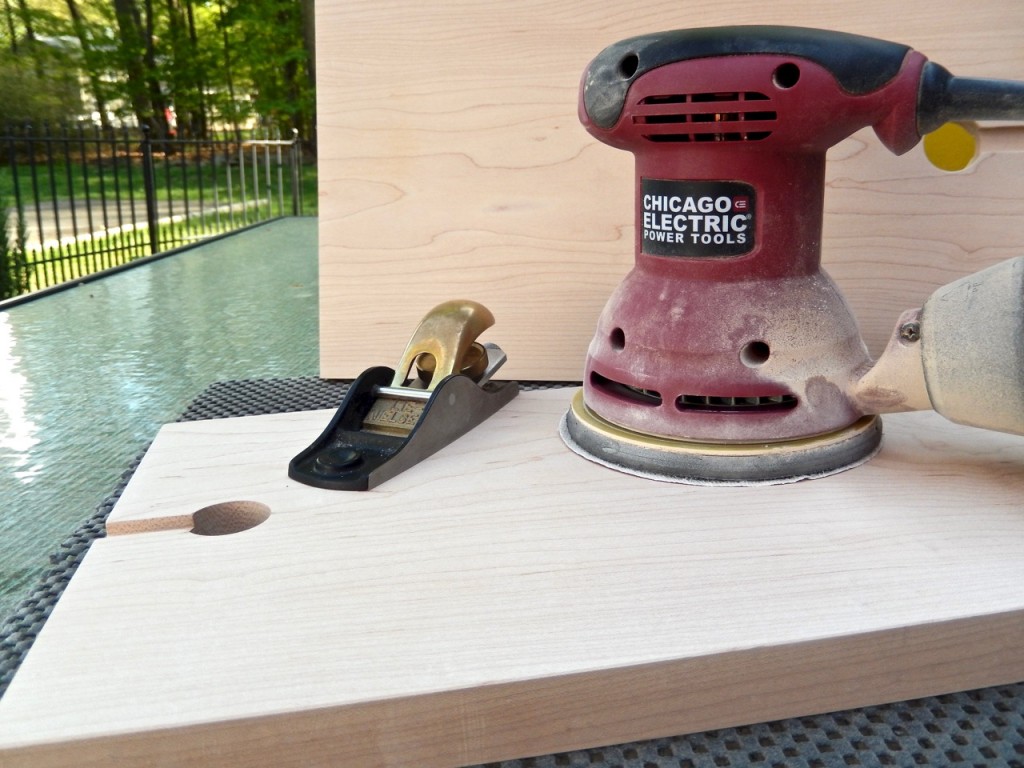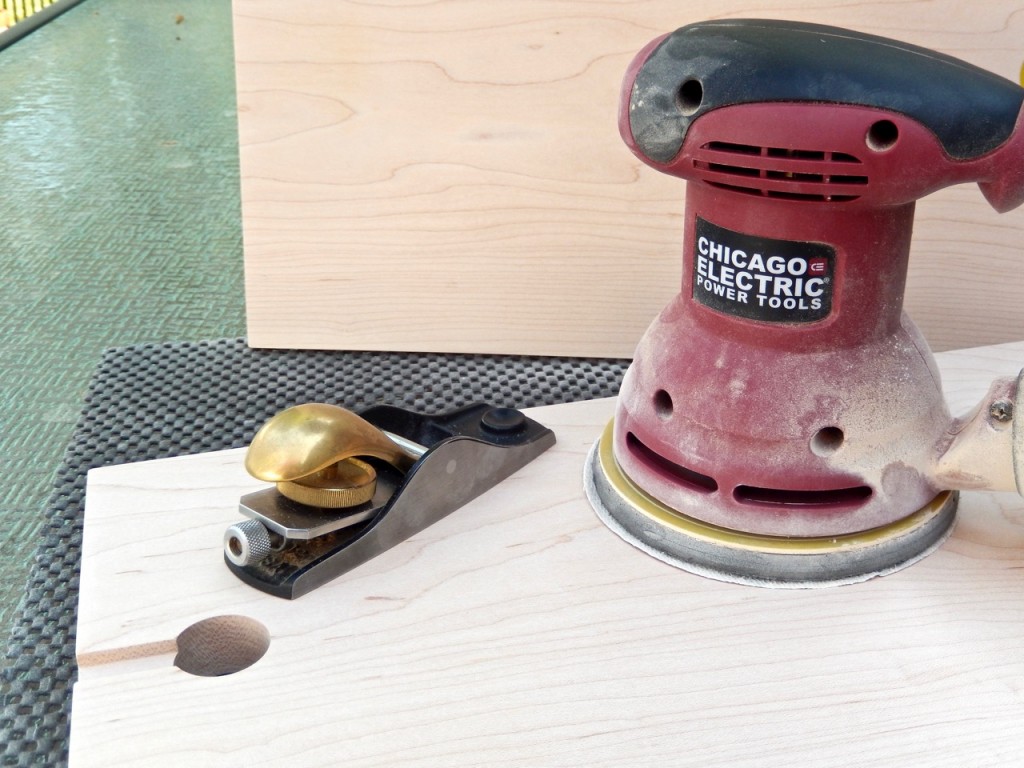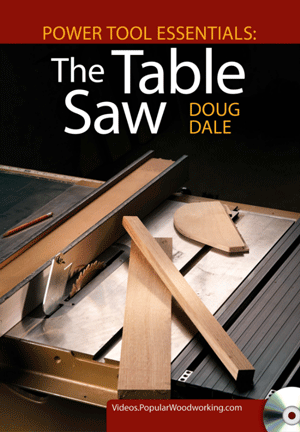We may receive a commission when you use our affiliate links. However, this does not impact our recommendations.

Harbor Freight brand Chicago Electric sander, and my No. 102 Lie-Nielsen Iron block plane, which is unfortunately discontinued. These days Lie-Nielsen is offering only the bronze version.
I prefer working with hand tools as much as I can. I find them much quieter, safer and more fulfilling than machines. I believe that only when using a hand tool can one become intimate with the essence of woodworking — sensing wood’s density, manipulating its grain, listening to its whispering sound when layers of shavings are carefully peeled off under the sharp edge of a handplane.
Don’t get me wrong, I could not succeed in my line of woodworking without the assistance of machines, yet planes, chisels and handsaws are more dear to my heart, hand and yes…my pocket. When I build my cutting boards, I rely on stationery tools to mill, cut to size, groove and drill my design. But I also find that there are cases when a handplane is indispensable for surfacing boards with capricious grain or for chamfering corners. With a small block plane I can chamfer the corner of the boards fast and efficiently, and because I like to use my planes, there is no reason to set up the router table with a 45° router bit to do the same job with more noise. Furthermore, a sharp top-notch block plane will allow you to cut with the grain in almost every grain configuration, whereas a router table setup might not.
While I feel reverence for most of my hand tools, and I acknowledge the indispensable contribution of the big electrical helpers for rapid manipulation of wood, I feel quite indifferent when approaching the dusty realm of sanding. I have no passion for sanding and no fetish toward the tools that I use.
My approach is boring and utilitarian: I wish to pay the least for the tool that will last the longest time without falling apart. I learned from experience that even tools that carry the hallmark of fancy brands may only last just a few months of intensive sanding work, so it just doesn’t make any sense to buy them when you have a cheap alternative at half the cost.
This is why I bought my Harbor Freight orbital sander. The tool is so cheap that even if it falls apart in half the time that say a DeWalt sander will, it will still be cost-effective. The only thing that bothered me was that once this tool met its maker (unfortunately most of our cheap electric tools these days are impossible or impractical to maintain) I would be responsible for yet another blob of plastics and metal parts that ends up in the landfill (yes I am that kind of a guy who cares for my environmental footprint). However, my initial trepidation had gradually subsided the longer I used this sander. After two years of routine use, though not “industrial” use, I can say that the sander has paid for itself a few times. It is still going strong and except for its inadequate dust-collecting bag (which is why if the weather is good I prefer sanding outside), it does its job probably as well as any top-notch brands out there.
While I don’t anticipate any major change in my attitude toward sanding, there is always the possibility that sometime down the road things will change, perhaps I might even meet “the right tool” that will scratch my heart. Do I hear a Festool whispering in my ear?

I use the No .102 (and other handplanes) for chamfering my boards’ corners. The inexpensive Harbor Freight random-orbit sander is very handy for surface sanding. The only problem with its design is the dust-collection system.
 It doesn’t matter which brand of table saw you use, you need to know how to perform maintenance and use it properly. Check out “Power Tool Essentials: The Table Saw” at shopwoodworking.com.
It doesn’t matter which brand of table saw you use, you need to know how to perform maintenance and use it properly. Check out “Power Tool Essentials: The Table Saw” at shopwoodworking.com.
Here are some supplies and tools we find essential in our everyday work around the shop. We may receive a commission from sales referred by our links; however, we have carefully selected these products for their usefulness and quality.










I also do like to spend high dollar for tools that do the same job as expensive name brand tools. The harbor freight sander round dust bag port adapts easily to a shop vac and with the use of an i-socket Tool and Vacuum Switch, available from Rockler, does a very good job of dust collection. I also have several name brand sanders and the performance is not perceptively different when attached to dust collection. For the cost vs usage, I couldn’t justify the festool.
Inadequate dust collection? That’s exactly the reason to spend more on a Festool sander. I was tempted to buy a Harbor Freight belt/disk sander because it was so cheap, but then I read the reviews and dust collection was poor. Sanding produces too much dust, especially fine dust, to not take advantage of tools with superior dust collection.
Almost all my work is outdoors, but I have four power sanders, a belt sander for the ugly stuff (Harbor Freight), a random orbit sander (Porter Cable) for most of my work, a Black & Decker random orbital that happens to have an attachment for corner work, and an ancient Craftsman (I really can’t remember when I bought it) half sheet “flat iron” sander that doubles as a random orbit(?) and a finishing sander. The best thing that’s happened to me was the receipt of a gift of Rockler’s small dust collection hose. It fits both the belt sander and the Porter Cable. With my shop vacuum attached, I can sand without wearing at mask for the generated swarf. The Craftsman is what I use, with the grain, for the final grit on a project (with a mask) so the swarf generated is minimal. Small areas, edges, etc. are handled by multiple sanding blocks with a hard side and a “soft” cork side. The blocks are all labeled with the grit of the abrasive being used. I’ve found that it’s easier to do that than to wrap and unwrap a single block with successive grits (I learned this in woodworking class from a Master Craftsman).
I HATE sanding. I’ve owned 5 RO sanders, so far, and the Milwaukee is the least vibratory and most comfortable of the lot. I still use a 6″ DeWalt for large surfaces and I peruse a different method for dust collection. I do it outside with a box fan blowing the offending dust cloud away from me. If I do alot of sanding, I have to get out the leaf blower and blow off the driveway and the greenery or else suffer the slings and arrows of my missus’ discontent. I also use a decent particle mask too.
Maybe when I win the Power Ball, I’ll throw down for the Mirka but I’ll still do it outside.
I like your logic, overall, and have applied it myself in some instances. However, I won’t be going this route with a sander for two reasons which have to do with my personal health: dust collection and vibration. My cheap sanders (and even my pretty darn good Makita) left my hands tingling after a couple hours of sanding. Gel-filled gloves cut the problem in half but didn’t solve it. Spending 2.5x the cost of the Makita for the small Festool random orbit (not the over-the-top Rotex) did solve it. Add to that the freakishly effective dust collection (I hook it up to my old shop vac, didn’t spring for the Festool sucker) and I am now a much happier sander. The new sander is far easier to grip, and in fact the vac is so effective that it holds the sander down on a flat workpiece and makes it feel lighter.
If nothing else, at least rig up a short length of radiator hose and some hose clamps to connect your sander to a HEPA-filtered shop vac. Your sinuses will thank you.